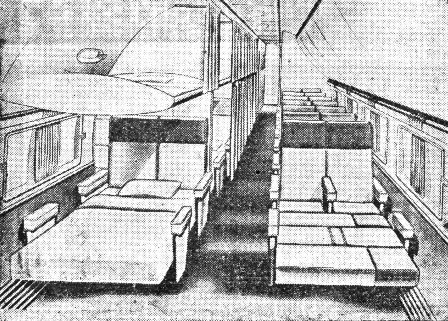|
|
|
BOND FREE |

|
|

|
UNHERALDED TRANSPORT UNIT
PERFORMS HERCULEAN MISSION
Little or no publicity has been given a new top-notch air supply organization now operating in the China Theater.
This outfit has done about everything from transporting troops to carrying butter and eggs. It's a gypsy unit in which everybody flies, and it never remains in one spot long enough to get weary of a station. Its nomadic tendencies have carried it all over the world and where its planes have gone so has every last man. No one has ever been able to define the organization's mission with any accuracy because it has done about everything, and always with the reliable C-47.
The men at the top are experienced airline pilots with thousands of miles and hours of flying behind them. The pilots, crew chiefs, radio operators, and ground men who keep these planes going are all highly trained personnel who work ceaselessly to keep operations moving swiftly.
In the evacuation of the last string of isolated American bases in China this hitherto unpublicized unit played a major role. These bases had to be abandoned on short notice with the utmost speed. A number of transports from this crack transport group were assigned to perform this duty. The evacuations were carried out under the worst possible flying conditions. Despite ice and sleet, electrical storms, heavy winds, magnetic and atmospheric conditions, mountainous terrain, overloaded aircraft, enemy planes and ack-ack, the job was done with the loss of only one ship and its crew.
At one time during the evacuation as many as eight planes were sending may-days. Often a dozen transports were up there trying to find an opening, hoping the compass would come around, firing flares to see whether they were still with the formation, being tossed around like feathers in the wind, trying to contact ground stations for a position check, hoping the gas would hold out, wondering where the next peak was located, hoping the ice wouldn't force them downstairs - a nightmarish situation, but just another job for this outfit.
When it was all over, there was a dash for the mess hall, bull sessions, discussions on the flying weather, perhaps a few letters to write, and then - well, tomorrow was another day with more work to be done.
CHINESE GAIN IN HANKOW AREA
CHUNGKING - Early this week the Chinese Army wrested the initiative from the Japanese attacking along the Canton-Hankow railway, throwing the lie to the Jap claim that the railroad is completely under their domination. Not only had the Japs failed to seal it, but lost two points to counter-attacking Chinese who also smashed into Pingshek, about 170 miles north of Canton.
A Chinese spokesman revealed that the Japanese sent reinforcements to the Shanghai area and to northern Indo-China as part of their precaution against an American landing on the Chinese coast.
After failing to prevent the invasion of Luzon, the Japanese haven't the slightest hope of preventing an American landing in China with its very much longer coastline, the Chinese spokesman pointed out.
The Chinese are rushing through plans to enable them to collaborate to the utmost with the Americans when they land on the coast. In his opinion, the spokesman added, if the Japanese planned the invasion of Yunnan to cut the terminus of the Stilwell Road to India, they were too late.
|
Plan To Electrify China At Yangtse
NEW YORK, Feb. 15 - Plans for the construction of the world's greatest concrete dam spanning China's Yangtse Gorge have been drawn up and are now under study at the engineering headquarters of the Federal Bureau of Reclamation, Denver, Colo.
John Savage, chief designer of the bureau, designed the plans, and is now on loan to Indian and Chinese government agencies. It is believed that he is at present studying India's water and hydro-electrical resources.
The proposed Yangtse Dam would be built above Chungking and would have a capacity of 10,000,000 kilowatts - double the capacity of the reclamation projects in the United States. It would supply electricity from Nanking in the east to Chengtu in the west, and from Kweilin in the south to Tienshu and Taiyuan in the north. Locks would permit navigation by 10,000-ton ships as far as Chungking.
With one eye on the distant future, provision is being made for the housing of the hydro-electric works in bomb-proof caves.
|
PATCH DESIGN; EASY TO WIN!
As the competition to select a new shoulder patch for the China Theater rolled into the second week, the number of entries arriving at Theater Headquarters increased. Prize for the winning design is a $100.00 War Bond.
The contest, which was announced last week by Lt. Gen. Albert C. Wedemeyer, commanding general of the China Theater, is open to all U.S. military personnel now serving in China, and closes March 1st. Entries should be mailed to the Public Relations Officer, Hq., USF, CTO, APO 879.
It doesn't take a professional artist to hit the $100.00 jackpot in this contest. All that is required is that complete and accurate explanations accompany all entries - colors, symbols, heraldic references, if any - need only be clearly identified. A single contestant may send in as many entries as he pleases - but each one should contain the full name, serial number and APO of the contestant.
An amateur with a "sharp" idea has as good an opportunity of winning the $100.00 War Bond as a professional artist. When the board selected by the commanding general gathers to chose the winning design it will be influenced more by the ingenuity of the design than the actual workmanship on the entry.
A couple of tips: neither a dragon nor the color yellow will be considered - although gold is acceptable.
Almost everyone has an idea for the new shoulder patch. Put it down on paper - and mail it in - it may win you a $100.00 War Bond!
|
1339th AAF BU, CHINA - No, this is not a Rube Goldberg invention. It is a bead breaker used to break the tire away from the rim of an aircraft wheel.
When Pfc. Sam Kurow of Cincinnati, Ohio, and Pfc. Charles Foster of Marion, N.C. found out that it took anywhere from an hour to an hour and a half to break the bead of a tire away from the rim they put their heads together and built this bead breaker. As a result the times was cut to approximately three minutes. Working in their spare time
|
|
AS US ARMY INTERPRETERS
CHUNGKING, Feb. 15 - The first graduates of the 1,500 interpreters being trained for liaison with the U.S. Army in China were introduced to the public this week. One hundred and forty-seven of these schoolboys, turned soldiers have just completed two months intensive training in military terminology and conventional English as related to war.
Addressing them, Lt. Gen. A. C. Wedemeyer welcomed them to the team that is playing with Tokyo for the goal. Gen. Wedemeyer was introduced by Maj. Gen. Ho Han-jo as "the Lafayette who came to China" and the man who would "build the Wedemeyer Road to Tokyo." Wedemeyer declined these tributes and said the task of beating Japan in China was no one-man job. He called on every man, woman, boy and girl to play their part.
All the interpreters will be recruited from the junior classes of the Chinese universities. They graduated with rank of lieutenant-colonel in the Chinese Army. They are assigned to every unit of U.S. troops in China.
New Navy Search Plane 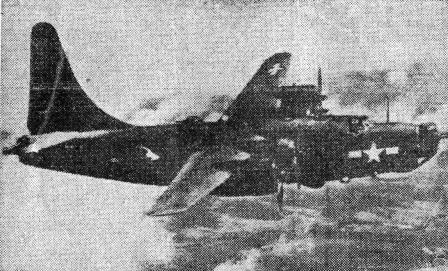 The "Privateer," new Navy search plane, makes its first public appearance. Modeled after the B-24 Liberator,
it has greater range, speed and fire-power, and carries considerably more equipment. It is considered one of the most
efficient search planes in existence and can range 1500 miles from its base, defend itself and attack the enemy. It
will be used mostly against Japan.
The "Privateer," new Navy search plane, makes its first public appearance. Modeled after the B-24 Liberator,
it has greater range, speed and fire-power, and carries considerably more equipment. It is considered one of the most
efficient search planes in existence and can range 1500 miles from its base, defend itself and attack the enemy. It
will be used mostly against Japan.
|

|
|
The China Command Post wants a new name - a name submitted by one of it's soldier-readers. And this GI journal is going to reward the soldier submitting the new nomenclature with a $100.00 War Bond in fact the easiest $100.00 he ever tucked away or sent home to the little women.
Any member of the U.S. Armed Forces assigned to the China Theater is eligible to win this newspaper's name contest. And there's not much to do to win. Simply write your entry on a piece of paper and mail it to the China Command Post, Hq., SOS, Kunming. Remember - each contestant may submit as many entries as he pleases - but each entry
|
All entries must be in the hands of the judges by February 25 - and all those postmarked up till midnight of the 25th will be considered.
The judges have no preconceived notions about the new name for the China Command Post - and the name you submit may walk off with the honors - and the $100.000 War Bond.
The name contest not only offers an opportunity to win distinction (wrapped in gold) but is also a challenge to every American soldier in China to test his wits and ingenuity. The winner will undoubtedly receive notice in the newspapers back in the United States for naming the China Theater's newspaper. And he will have made a very definite contribution to the Theater - one that is destined to endure forever in the memories of the men who helped fashion an Allied victory from this side of the Hump.
So from every point of view this contest is worth your while. There's lots of incentive - plus a sizeable chunk of gold. Now get out of your sack and let's have your entry - it may win you modest fame and fortune!

|
Bamboo "Little Inch" |
|
ATC Squad Sets New Mark
1343RD AAF-BU, ICD-ATC BASE, CHINA - Through dust and grime the maintenance section of the famed "Yellow Nose" squadron at this ICD-ATC base established in January an all time record for the unit in keeping the engines running.
More inspections, more engine changes, more hours flown and more maintenance headaches in general fraught the engineering section, but they came out on top although operating in the open where dust storms are an every day occurrence.
Under the watchful eye of M/Sgt. Richard F. Stanford, Russellton, Penn., Squadron line chief, engineering personnel labored late at night knowing their work was necessary for precision flying operation . . . such as the Suichwan evacuation for which this unit was highly commended for in January.
Without hangars or sheds, working entirely in the open except for an occasional tent where oil and fine instruments were kept, the section changed almost two engines for every assigned aircraft and an average of one propeller for each plane. A total of 236.2 hours flying time was logged as an average for each ship . . . four flew in the 300 hours bracket and one veteran Commando put in 350 hours before it answered sick call for an engine change.
"How did we do it?" answered Sgt. Stanford to the number one question, "Other than the usual competition between crew chiefs we just maintained normal operations and good team work. Would have been a darn sight better if we hadn't lost 63 plane days waiting for parts."
Engineering worked without thought of goal or record, according to the CO, Maj. F. S. Sylvester, and rumor has it that he is planning a special little party for the section.
|
KUNMING
. . . Shanghai Of The West |
|
|
SPRAWLING ON A HIGH plateau in a beautiful Chinese valley of lakes and high terraced paddy-fields lies the ancient city which each day becomes more and more significant in the military destiny of free China.
The city is Kunming, capital of Yunnan Province, terminus of the newly opened Burma Road, strategic road link with Chungking and Kweiyang, headquarters of the famous Fourteenth Air Force, biggest center of ATC operations across the Hump, and virtual military capital of all free China's combat operations.
The war which has devastated so many other cities of China has brought wealth, progress, and enormous development to Kunming - the city which for so many centuries was looked down upon by sophisticated Chinese of eastern cities as a wild, uncultured center of tribes-people, war lords and bandits, a primitive frontier country suitable for political banishments and little else. Things have changed a great deal since then.
Few cities in all China have so swiftly absorbed modernism and the paraphernalia of the Western world. Yet, outside the airfield and garrison areas and new modern style buildings which have sprung up in a strangely ugly rash amid the high walls, moon gates and horned roofs of old China, the real Kunming has remained picturesquely mediaeval with all the contrasts of real beauty and abysmal filth, smart sophistication and sheer primitism, fabulous wealth and unbelievable poverty, quietly charming old-world courtyards and dreadful alleyways stinking with disease.
Smartly dressed Chinese business men and women in slick polished limousines roll along the cobblestoned streets with horns blaring and scaring blue trousered coolies and strangely barbaric Lolo and Misu tribesmen down from the mountains and bent double beneath their great burdens of Charcoal and firewood and hay. Modern factories stand on the edge of paddy fields where ragged farmers plod behind their water buffaloes or irrigate their little farms with the same primitive equipment their ancestors were using fifteen hundred years before. Near the massive brickwork of ancient tower gates are streets of modern shops and imposing banks.
Twin pagodas of the Tang dynasty surmounted by bizarre metal peacocks stand in the midst of the ruins of the Moslem revolt of the last century and a block away are shops crammed not only with tawdry pieces of gimcrack but with all "the luxury goods of the Western world" - fountain pens priced at one hundred dollars gold, ready-made Western suits at fifty thousand Chinese dollars and moth balls at ten dollars each.
In the morning when Kunming swarms to wakefulness, army jeeps rattle by with every driver's thumb down
|
Because only very recently Yunnan Province was the most barbaric, uncultured and backward area of all China there is little accurate data on Kunming's beginnings. Some sort of settlement existed here two thousand years ago. A thousand years ago the people of Kunming discussed the feasibility of driving a road westward into Burma - a dream that did not become a reality till a quarter of a century ago.
Before the time of Marco Polo, Kunming existed as a city and by the fifteenth century it vied with beautiful Tali as the cultural center of China's far west. But to the rest of China it remained a wild area suitable only for criminals, bandits and political exiles. More sophisticated westerners quoted the old adage, "Yunnan ta tsui," meaning roughly that anybody who lived in Yunnan must have committed some flagrant crime. But it was this very character that gave Kunming much of the picturesque flavor it retains today.
Three hundred years ago Wu San-Kwei, doughty Ming Dynasty general was exiled by Manchu invaders to Kunming - kicked upstairs with the polite title of King of Southwest China. Wu took with him from Peking thousands of scholars, architects, artists and artisans and proceeded to rebuild Kunming on the model of the famous and beautiful Peking. Much of Kunming's fascination and charm today stems from the political banishment of Gen. Wu.
One walks today through squalid little lanes covered in filth and fringed by grimy shops and comes suddenly on the beautiful imperial parklands with quiet lakes and pretty grottos and small temples.
Locked within the area's grubby booths is a miniature forbidden city straight off the willow pattern plate.
Concrete skyscrapers are rising above the old battle-scarred south gate tower which rears massively above the ancient wall, and the Peking-roofed skyline of the old city is dwarfed.
The hub of the city's commercial life and market bustle swarm beneath great curved tiled roofs of the two ancient stone arches or "pi faung" - arch of Bi Chi the jade phoenix - and arch of Chin Ma the golden horse built centuries ago to astronomical principles of such accuracy that once in every necromantic sixty years the shadow of the Jade Phoenix Arch cast by the setting sun and the shadow of the Golden Horse Arch cast by the rising full moon meet exactly in the center of the street between the two arches. The next time the phenomenon will occur will be in the year 2003.
Today there is much of Kunming that resembles a rip-roaring, wide-open frontier town. Yet ten years ago Kunming was one of the most inaccessible, primitive cities of the world. Western civilization has come ruthlessly, swiftly and boisterously to this old city where the great marketplace called Civilization Street is ironically and idiomatically known as Thieves Market, where it is said one can always purchase back, at a fantastic cost, any article that one has lost or had stolen the day before.
Before the beginning of the Sino-Japanese war in 1937, Kunming had no industries and supported a simple agricultural population of one hundred and fifty thousand, mostly peasants, coolies and small merchants. The cost of living was the cheapest in China. Today Kunming has a population exceeding half a million. It's one of the most heavily industrialized areas of China, it has become an enormous center of business and banking and its cost of living is highest in China and among the highest of any city in the world. The influx of population came from bankers, industrialists, scholars driven out of Peking, Nanking, Shanghai, Hong Kong, from business opportunists, from poor refugees, from soldiers of fortune, from taxi dancers and prostitutes from night clubs of Saigon, Shanghai, Kweilin, Hong Kong. Almost overnight the city became the new Shanghai of the west. Chennault's Flying Tigers had headquarters there - so had racketeers preparing to begin great smuggling ramps - and the town was wide open.
The Burma Road was opened and Kunming roared with the vast boom of trade, prosperity, easy money and crime. Factories rose like mushrooms from quiet plains, great mansions of the noveau riche began to sprawl with hideous incongruity across the charming Chinese architectural scene. Culture came too, because three of China's greatest universities - Nanking, Peking national and Tsing Hwa - fleeing hundreds of miles before Japanese aggression, came to Kunming to establish, in the shadow of ancient massive walls, a compositive university that has become one of free China's leading seats of culture.
But the rash of modern buildings spread like disease through the new city, outside the old walls thousands of American soldiers and airmen arrived and the noise of jukeboxes drowned the more ancient clang of gongs and the scrape of moon guitars.
Sophisticated nightlife migr s from coastal cities lost no time in establishing new night clubs, new "hostess circles," and new bars and saloons where terrible semi-lethal potions of raw power alcohol officially labeled "whisky," "rum," "gin," were sold to stomach-tortured soldiers who lumped these fiery fluids with Chinese rice wine under the generic term of "chin pao juice," chin pao meaning air raid alarm. Today in China a bottle of the cheapest rice wine costs nine hundred dollars. A bottle of deadly synthetic "scotch" sells for three thousand dollars and more - and generally you either drink the stuff or remain a teetotaler.
|
But the roaring free and easy night life of Kunming is only one of its many facets. There is ever present an atmosphere of almost forgotten centuries coupled with the poetry of its place names. Kunming means British Omen, Yunnan means Southern Cloud. It has a Street of Gold-beaters, Street of Thieves and a Street of Crippled Men. And on the mighty and beautiful mountains that form the western ramparts of Kunming valley, one of the most beautiful plains in China, are the temples of the Western Clouds with their vast gold buddhas and cave walls with thousands of saints, gods and demons carved from living stone. And in a little room behind the temple proper is a vast pile of books, old manuscripts on bamboo and silk and tens of thousands of modern books on sociology, medicine, science, history, literature - cultural treasures of colleges now in occupied China carted hundreds of miles across China's vastness to be locked away in the rocky caves of a thousand-year-old mountain temple until peace returns to China and scholars can browse again through their books.
Between the western hills and the city proper cupped with a tremendous valley brilliant with shimmering canals and emerald Chih on which the vast twenty mile long lake of Tien paddy fields, is thousands of junks and sampans ply like fussy, restless, water beetles. It would be difficult to imagine any landscape more unlike that of America and yet at almost every turn the American can have a sudden curious feeling that he is back home - a feeling almost invariably dispelled by the sight of the horned caves of Chinese cottages or peasants with cartwheel hats plodding behind pony carts or shambling along with panniers over their shoulders. But if the players are definitely un-American, the backdrop is often astonishingly like the American countryside, Kunming at an elevation of over 6,200 feet has the best climate in China. It's almost a land of perpetual spring with every day like a warm spring day in the Rocky Mountains. There is the same warmth of coloring, the same vast blueness of sky, the same crystal clarity in purple mountains. And if one gets away from paddy fields and people there are many corners where an American can sit and never know he is in a foreign land.
Familiar landscapes, American troops, Chinese people and architecture do not add up completely to the cosmopolitan character of Kunming. Living in the city are adventurers from all over the world. Much of the city has a pronounced French influence - many of the troops and all the policemen wear French-style steel helmets - because until Japan clamped its blockade around China, Kunming was the terminus of the railway route from Hanoi in French Indo-China and even today a great many shops and business houses carry French signs over the doorways and on facades.
Today French influence is rapidly disappearing under the swamping influence of the United States. Kunming is changing swiftly. It has changed tremendously in the last ten years. How much will it change in the coming decade? Already it is the center of a vast network of communications by road and air. It is the focal point of a system of mighty airfields of which Kunming's main field is reputedly the busiest in the whole world. It is the new home for countless tens of thousands of refugees driven in from the conquered provinces of Chekiang, Kwantung, Kwangsi. It has, in this last week, become again the terminus of the vital Burma Road. It has become the center of industry and business. Ten years ago Kunming didn't have a single newspaper, today it has six dailies. It is a great crossroads for armies on the move - slogging along stretching roads to and from the western front beyond the Salween from northern war areas, backward and forward between Kunming and the vital eastern front where only a few weeks ago the Japs were driving toward Kunming itself, moving down rutted roads to the southward and the silent, tense mystery of Indo-China frontier.
Over the great green bowl of Kunming valley, combat aircraft fly endlessly - sharknosed fighters and big bombers. And in sheltered valleys and satellite villages the simple people of China go on with their lives as they have for countless centuries - plodding wet paddies behind shambling water buffaloes, bringing up precious water by treadmill, leading their pack a trains of mules and tiny Mongolian ponies along traffic thronged roads, choking narrow lanes with the constant bustle of a conglomeration of humanity that never seems to stand still - peddlers with toys and joss sticks and sweetmeats, food vendors crying their wares and beating their tiny metal cymbals far into the night, rickshaw coolies chanting their toneless songs, peasants and beggars and slim rouged girls with skirts split to their thighs, hurrying through the crowds. Booths with silversmiths busy behind windows screened with red paper through which lights shine dimly, the tap of hammers and rasp of saws in the street of coffin makers, the small of incense and shrill wailing of fiddles and clashing of brazen gongs. And the drone of aircraft,
|
In view of the last ten years of Kunming's history, who would predict the next ten? But at least the city of Bright Omen in the land of the Southern Cloud will never again be merely China's barbaric, primitive Siberia.
|
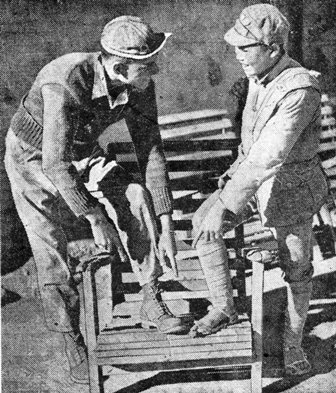 Pfc. William Carroll, Philadelphia, Pa., argues out the merits of the GI brogan vs. the sandal with a Chinese soldier
at his ATC base in China. Carroll works in the Tech Supply section and has been with the ICD-ATC in China for 14 months.
Pfc. William Carroll, Philadelphia, Pa., argues out the merits of the GI brogan vs. the sandal with a Chinese soldier
at his ATC base in China. Carroll works in the Tech Supply section and has been with the ICD-ATC in China for 14 months.
|
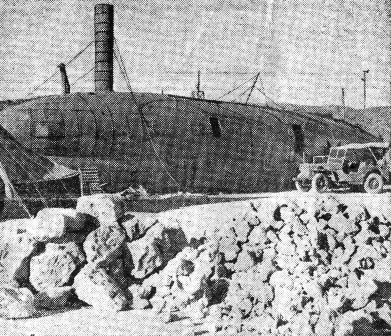 Men of a China ATC base have fashioned the salvaged fuselage of a wrecked C-46 into a combination mail room, dayroom
and snack bar. A partition divides the tail from the rest of the former spacious Hump flyer, and there mail is sorted and
distributed. The center section is a dayroom with writing tables and books, and the nose contains a snack bar complete
with stove, service counter and stools.
Men of a China ATC base have fashioned the salvaged fuselage of a wrecked C-46 into a combination mail room, dayroom
and snack bar. A partition divides the tail from the rest of the former spacious Hump flyer, and there mail is sorted and
distributed. The center section is a dayroom with writing tables and books, and the nose contains a snack bar complete
with stove, service counter and stools.
|
The view at the left shows how the B-29 might look with the addition of an upper deck which would give it a capacity of 35,000 pounds or 100 passengers. Below are pictured the 36 berths in the cabin of the ship which will be equipped to maintain constant air pressure permitting it to fly at high altitude above storms. The right foreground shows how the seats will be converted into berths at night, while at the left a lower and upper berth is fully made up. The plane will have a maximum range of 3,500 miles and a cruising speed of 340 mph.
|
 Battle Ground Of The Near Future
Battle Ground Of The Near Future
This is the east coast of China, where a great decisive battle of the Japanese war will be fought. Adm. Chester W. Nimitz, Pacific Fleet Commander, says Allied forces will land here and seize a port for operations against the Japanese mainland. The invasion of China has been hastened by the U.S. naval victory in the second battle of the Philippines in October, 1944, when the Jap fleet was destroyed as an effective fighting force. |
CQ Report Three o'clock, and all is well - Smith and Jones have gone on guard, And now their footsteps die away. The night is chill and many-starred. Within the tents in khaki rows, The soldier scores lie dreaming. The little town sleeps on its hill And not a light is gleaming. This is a hushed and quiet hour - Slumber, soldiers - dream and smile; Rest, ye weary, war-torn town I will watch with God awhile. - Sgt. Virgil Scott |
|
Bended Knees Little Bones - You cause me so much misery, I call for seven you come up three haven't I always treated you right Kept you clean and nice and bright? Dotted Cubes - With your bouncing ironic behavior, I'm counting on you as my financial savior. Treat me right now, and apologize. Oh! You did it again - snake eyes! Little Dicies - I'm down to my last ten, Promise me you won't do it again - Big digs? Okay, make 'em see stars! You - you gave me box cars Dear Wifey - No fooling honey, believe me please, I lost it, I swear, on bended knees Don't know just where or how or when But honey, I swear, it won't happen again. - Pvt. Robert E. Mott |
|
Appreciation And if I live to see again The land I claim by birth My eyes will surely rest upon The grandest place on earth, For I will see her rivers, Her mountains and her plains And I will think of men I knew In agony - in pain, Men who shaped her destiny With courage tried and true; Men who gave unselfishly; Men I'm proud I knew. And if I live to see again, Those wondrous Yankee shores, My wanderings will have taught me; To love her all the more. - Pvt. Larry Scheieber |

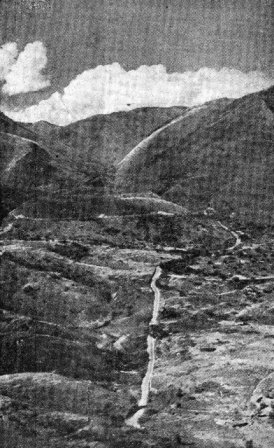 Hewn Out Of The Mountain
Hewn Out Of The Mountain Striking aerial view of a section of the newly-opened Stilwell Road. Photographed east of Wanting on the Burma-China border by a photographer of the USAAF Tenth Combat Camera Unit. |
 Old And New
Old And New Hard working mules and the rugged, versatile jeeps have both added their bit to the construction of the China-India road. Here the two pass along the Road somewhere in China. A typical oriental style blockhouse forms the background and on the right a Chinese soldier stands guard. |
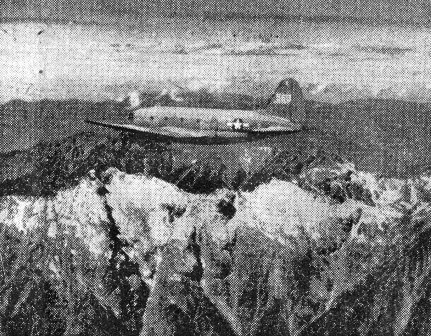 The Rock Pile
The Rock Pile Recent view of the Hump, one of the world's most treacherous air routes over which is flown an ever increasing flow of supply from India to China. Referred to as "the Rock Pile" by pilots it is usually enveloped in mist. |
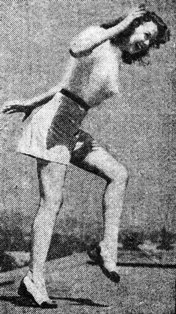 Easy To Take
Easy To Take Supposed to have enough energy for five average people (is that good?). Adele Mara's drum beaters are hailing her as the Vitamin Girl. Currently appearing in Columbia's "Good Luck, Mr. Yates," Adele - her press agent says - fills in most of her spare time entertaining visiting service men. What are we, civilians? |
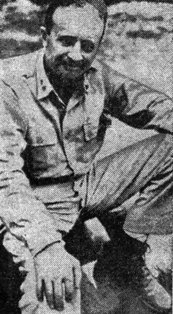 Manila Commander
Manila Commander Maj. Gen. Robert S. Beightler, commander of the U.S. 37th Infantry Division, elements of which entered Manila, capital of the Philippines, early this month. Two days after the original entry, three American divisions had surrounded the Japanese in the city. |
 Jubilant Filipinos
Jubilant Filipinos A happy group of Filipinos in New York celebrating shortly after the announcement that American troops entered Manila. Troops of the First Cavalry Division entered Manila on the night of February 4, pushed to the north bank of the Pasig and captured the civil internment camp at Santo Tomas. |
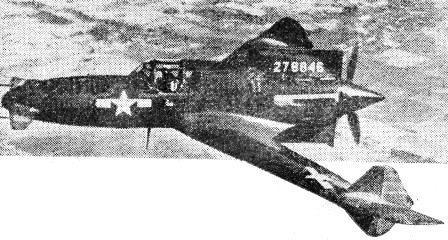 New 'Ascender'
New 'Ascender' New USAAF experimental fighter, the Ascender, fast, maneuverable and with a high rate of climb, the plane carries a gun in its nose. The position of the engine, propeller and wing surfaces behind the pilot and 'tail' fins in front of him constitute a revolution in plane design and give the impression that the plane is flying backwards. |
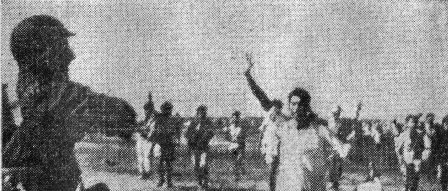 Liberators
Liberators Filipinos greeting the first American troops to land on Luzon. Scene has been enacted many times since as Filipinos all along the way welcomed the Americans. |
 Life Can Be Beautiful
Life Can Be Beautiful 1343 AAF BU, CHINA - Sweet oblivion to the cares of this wicked world. These two ICD-ATC pups pick out a nice comfortable spot on their master's fur flying jacket, worrying no a bit about the woeful lack of dry cleaning facilities in China, and calmly chew on each other under the warm Yunnan sun. |
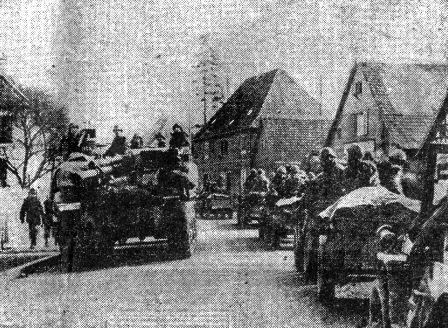 Seventh Army Approaches Reich
Seventh Army Approaches Reich War machines of the Seventh U.S. Army rolled toward the German border in the area of Wissembourg. The Seventh was the fifth Allied Army to cross the border; the U.S. First, Third and Ninth Armies and the British Second Army were already battling in Germany. |
The CHINA COMMAND POST is the weekly newspaper of the United States Forces in the China Theater and is published by Lt. Lester H. Geiss, Editor-in-Chief, for military personnel only. T/Sgt. Harry Purcell, Managing Editor; Sgt. Maurice Pernod, Production Chief. Editorial offices: Hqrs., SOS, China Theater, Kunming, China, and Hqrs., SOS, Calcutta, India. Printed by Ajit Kumar Sinha at the "Amrita Bazar Patrika" Press, Calcutta, India.

FEBRUARY 16, 1945
Original issue shared by Paul Shindelar
Photo of C-47 did not appear in the original newspaper.
Copyright © 2009 Carl Warren Weidenburner
TOP OF PAGE
PRINT THIS PAGE ABOUT THIS PAGE
E-MAIL YOUR COMMENTS
CLOSE THIS WINDOW

 Pfc. Sam Skurow, left, Cincinnati, Ohio, and Pfc. Charles Foster, Marion, N.C., proudly display their bead breaker.
Pfc. Sam Skurow, left, Cincinnati, Ohio, and Pfc. Charles Foster, Marion, N.C., proudly display their bead breaker.
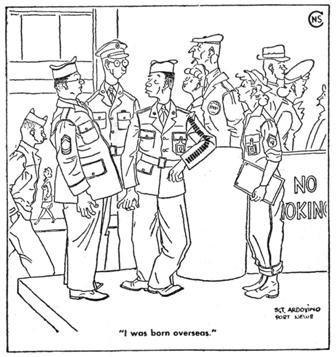
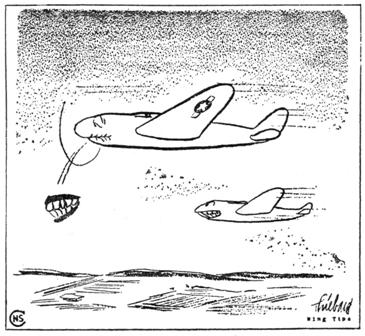
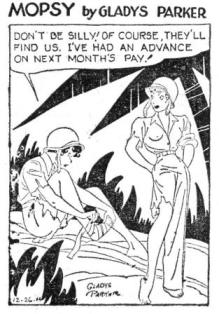
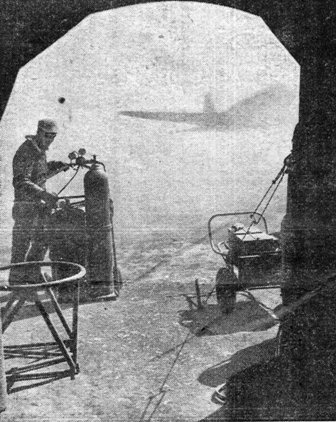 The camera pokes from the shelter of one of the few engineering tents and catches an unidentified airplane mechanic pushing his equipment through the cloud of dust that almost totally obscures the Commando in the background. He is one of the engineering section that set the maintenance record for the squadron in January.
The camera pokes from the shelter of one of the few engineering tents and catches an unidentified airplane mechanic pushing his equipment through the cloud of dust that almost totally obscures the Commando in the background. He is one of the engineering section that set the maintenance record for the squadron in January.
 Kunming Canal, one of the principle arteries into the city, connects Yunnan capital with Kunming Lake.
Kunming Canal, one of the principle arteries into the city, connects Yunnan capital with Kunming Lake.
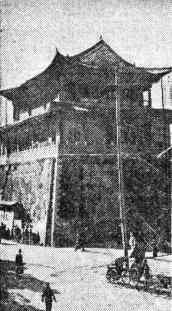 The Telephone Building facing Sun Park was formerly the old South Gate.
The Telephone Building facing Sun Park was formerly the old South Gate.
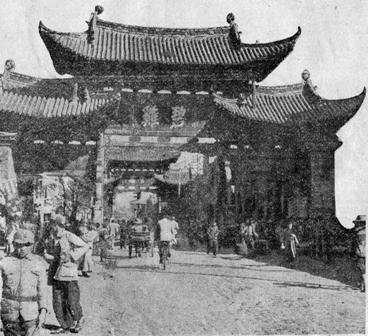 Chin Pee Road, main street of Kunming as viewed towards the Golden Horse Arch.
Chin Pee Road, main street of Kunming as viewed towards the Golden Horse Arch.
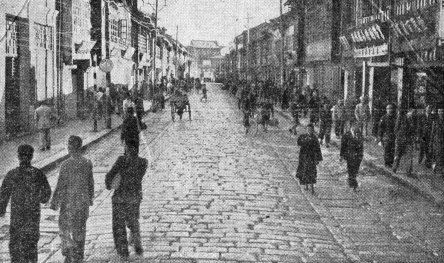 Cheng Yi Street in the heart of the city, looking toward the Near Sun Building.
Cheng Yi Street in the heart of the city, looking toward the Near Sun Building.
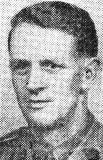 George H. Johnston, war correspondent for the Melbourne Argus, is a native Australian, currently reporting events in
China, Burma and India. A skilled hand at war reporting, Johnston was the accredited Time and Life correspondent
during the hostilities on New Guinea. He also saw action in Italy, Greece, North Africa and the Pacific. Johnston has
contributed articles to the Saturday Evening Post, Colliers and Coronet.
George H. Johnston, war correspondent for the Melbourne Argus, is a native Australian, currently reporting events in
China, Burma and India. A skilled hand at war reporting, Johnston was the accredited Time and Life correspondent
during the hostilities on New Guinea. He also saw action in Italy, Greece, North Africa and the Pacific. Johnston has
contributed articles to the Saturday Evening Post, Colliers and Coronet.

